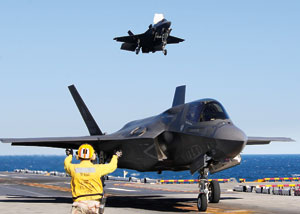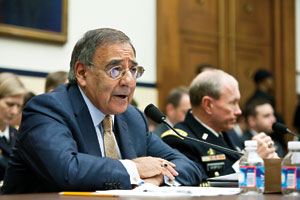CQ WEEKLY – IN FOCUS
Oct. 29, 2011 – 11:37 a.m.
In Downsizing Defense, Politics Trumps Strategy
By Megan Scully, CQ Staff
Pentagon officials are huddling behind closed doors to trim roughly $450 billion from the Defense Department’s budget over the next decade, and if history is any guide, the most frequent questions being asked are not about military missions, U.S. strategy over the next decades or what soldiers need to fight the next war. They’re about politics.

|
||
|
If the Pentagon can’t sell its plan on Capitol Hill, its ongoing review will be little more than an exercise in futility. Defense officials have to find cuts that will assuage lawmakers intent on protecting their districts and states from direct financial blows as the military’s budget declines for the first time since the late 1990s.
Of course, it was Congress itself that ordered the defense reduction as part of the Budget Control Act. Under that law, the defense budget is capped, requiring an estimated $450 billion in cuts below the Pentagon’s current projections. Additional cuts are also possible as a bipartisan congressional committee tries to devise a plan to reduce the nation’s deficit by at least $1.2 trillion over the next decade. If the 12 members fail to reach a compromise, defense spending faces an additional estimated $492 billion across-the-board cut that Pentagon leaders have said would be catastrophic.
The potential for Congress to bungle its cost-cutting task is not lost on Pentagon leaders. “I think that one of the great national security threats is the dysfunctionality of the Congress and its inability to confront the issues that we face now,” Defense Secretary
In terms of the cuts already on the table, lawmakers have pushed off the unenviable task of canceling programs and reducing the size and scope of the armed forces to Pentagon officials. But while the Pentagon must do the dirty work, members of both parties are working behind the scenes to save their pet projects.
For lawmakers, particularly those in leadership positions, the chance to exert their power is now, before the department delivers the results of its review to Capitol Hill early next year. But their insistence on protecting their own interests can have a distorting effect on any strategic effort to downscale the military.
Lessons Learned
Since World War II, six presidents have cut defense budgets with varying degrees of success, giving the Obama administration plenty of precedent and lessons learned as it navigates this latest drawdown. The current cost-cutting plans are modest compared with previous reductions.
In the decades following the Korean War, Vietnam War and Cold War, defense budget authority declined from its peaks by about 30 percent. Under the administration’s current cost-cutting plan, the Pentagon would reduce its budget by about 8 percent over the next 10 years, according to an analysis by the nonpartisan Stimson Center think tank.
But with a Pentagon and a Congress that have grown accustomed to a decade of seemingly bottomless defense spending, it will be no less politically painful. Outgoing Deputy Defense Secretary William J. Lynn III on Oct. 5 used his last speech in his post to bemoan the United States’ track record on defense cuts and to urge officials not to repeat the mistakes of the past — namely, depleting the fighting force of needed capabilities and personnel.
Lynn pointed to the Battle of Osan in 1950, when an inexperienced and ill-equipped post-World War II force faced a North Korean military that outnumbered them 10 to 1. To a lesser extent, the military is still feeling the effects of the so-called procurement holiday of the 1990s. The Republican-controlled Congress halted the cuts to the military’s acquisition accounts in 1998, but Lynn said problems with today’s aging helicopter and aircraft fleets date back to the budget decisions of the 1990s.
“In different ways, we are 0 for 4 in successfully managing defense drawdowns,” he said. “Each time we reduced the defense budget, we created holes in our military capabilities that we had to buy back at greater cost. When we were lucky, that cost was in dollars. When we were not lucky, the cost was in the lives of our troops.”
In Downsizing Defense, Politics Trumps Strategy
Some budget analysts, such as Gordon Adams, who oversaw defense budgets during the Clinton administration, dispute the notion that the United States has always failed in its efforts to reduce the size and scope of the military. Adams points to the powerful fighting force that quickly took out Saddam Hussein’s army in Iraq, noting that it was the product of the cost-restrained military of the 1990s.
But both sides agree that politics will be paramount during this round of budget negotiations, as it has been in the past. And unless the Pentagon can appease lawmakers, it will have a very tough road ahead on Capitol Hill.
“There’s a very strong political constituency that’s going to argue, and I think there’s going to be a fairly robust debate about the program and budget that comes up,” Lynn said.
Part of the Pentagon’s problem is its inability to prioritize its missions effectively. The department’s most recent Quadrennial Defense Review did little beyond validating the military’s existing missions and programs, giving lawmakers plenty of fodder to justify their campaigns against certain cuts.
The faltering economy, coupled with election-year politics, could make the Defense Department’s climb even steeper. A major weapons system such as the multiservice F-35 Joint Strike Fighter employs tens of thousands of workers in more than 40 states. Cutting or scaling back the fighter program would drive more people out of work, a risk that many on Capitol Hill do not want to take as they enter into an election year.
“When push comes to shove, it’s about my state. It’s about my district,” says Adams, who is now is an analyst at the Stimson Center. “A lot of the time, Congress doesn’t make it any easier to do something that is sensible.”
F-35 Test Case
Lawmakers and the defense industry took notice when new Joint Chiefs of Staff Chairman Gen.

|
||
|
What was supposed to be an affordable multiple-role stealth fighter has become a textbook example of the problems with the Pentagon’s acquisition system. The lifetime costs for the 2,456 jets the military plans to buy for the Air Force, Navy and Marine Corps has grown from $1 trillion to $1.4 trillion. When all is said and done, the program could cost over 80 percent more than original estimates.
Those cost overruns have made the program a target for criticism by Pentagon budget watchers. The Defense Department has long stood by the F-35, the largest program on the Pentagon’s books and its sole plan for replacing its aging fighters.
But Dempsey said flatly that the program as it’s envisioned now may simply prove unaffordable in the current fiscal environment. “Three variants create some fiscal challenges for us,” he told the panel, revealing for the first time that some top Pentagon leaders see the Marine variant as possibly expendable.
Republican Rep.
In Downsizing Defense, Politics Trumps Strategy
His response foreshadows the battle that will emerge — and the arguments that will be made — if the F-35 or any other large weapons program is targeted for cuts. Considering the broad constituency, the Pentagon would have a “hell of a time” cutting back the F-35 program, says a former senior Office of Management and Budget official and appropriations staff director who asked not be named.
Other programs have proved equally hard to kill. After all but abandoning its plans for a new destroyer in favor of a ship already in the fleet, the Navy remains locked into buying three DDG-1000 Zumwalt-class destroyers at a price of more than $6 billion per ship, including research costs.
But the program is very unlikely to get scaled back any more. The reason: General Dynamics builds the DDG-1000 at its Bath Iron Works plant in Maine, which is represented by Republicans
When it comes to large and entrenched programs such as the F-35 and the DDG-1000, the Pentagon can often avoid fights by prolonging the research and development phase, effectively slowing them down, rather than scrapping or curtailing them. Delay tactics would allow the Obama administration and Congress to push off hard decisions until at least after the 2012 election, says Lawrence J. Korb, a senior Pentagon official in the Reagan administration.
“Kick that can down the road,” Korb says. “Never make hard decisions in the last year of an administration.”
Indeed, during many of the previous drawdowns, research budgets have benefited even as procurement dollars have dropped, according to an analysis Korb wrote for the left-leaning Center for American Progress. For example, President Dwight D. Eisenhower, a retired five-star general, slashed defense accounts by 27 percent but doubled research and development as a hedge against the Soviet threat.
But Lynn has made it clear that he believes the first lesson of past drawdown mistakes is to make those difficult decisions early in the game. “Things are not going to get better. Budgets are going to continue to go down. Costs are going to continue to go up,” he said. “If we cannot afford it now, we sure cannot afford it in the future. And keeping programs alive in the hope that there will be more funds in the future is reckless and intemperate behavior.”
The result of squandering dollars on weapons and systems that will never see combat, Lynn argued, is a far less capable military.
As defense officials size up the military’s budget for cuts, they may be wise to eye weapons programs that are still in their infancies. Doing so could allow the Pentagon to skirt some political fights, although at the potential expense of military needs.
The Air Force’s next nuclear-capable bomber, for instance, exists only on paper. There are no contractors officially vying for the program and few, if any, existing jobs at stake. Also vulnerable could be the Army’s Ground Combat Vehicle. BAE Systems Inc. and General Dynamics Corp. both won technology development contracts this summer worth about $450 million apiece, but the vehicle is years away from full-scale production.
“The way to cut procurement without generating sizable protests from industry and workers is simply to not start new programs, because they don’t have a constituency yet,” said Todd Harrison, an analyst at the Center for Strategic and Budgetary Assessments.
Looking Beyond Weapons
Procurement isn’t the only area where cuts could be unpalatable on Capitol Hill. Lawmakers are already girding for deep cuts to the size of the armed forces, a move that could directly affect areas surrounding military bases.
In Downsizing Defense, Politics Trumps Strategy
Complicating matters are the thousands of recent veterans who are struggling to find jobs in a tough economy. Veterans who have served since 2001 had an unemployment rate of 11.5 percent in 2010, slightly higher than the national figures. But the unemployment rate for veterans 18 to 24 was 21.9 percent last year, and no lawmaker wants to exacerbate that figure during an election year.
Nora Bensahel, a senior fellow at the Center for a New American Security, said cuts to the military’s troop strength are inevitable, considering the Pentagon’s rising personnel costs. But many of those reductions will come later in the decade, particularly with troops deployed to Afghanistan until at least 2014.
“Any cuts to end strength are going to be drawn out over time,” Bensahel said.
Off the table, at least in the immediate future, are wholesale changes to the military’s retirement system. While Senate Armed Services Committee leaders see potential for long-term savings, they believe current retirees and servicemembers should be grandfathered in, effectively pushing any benefits of reforming the system beyond the next decade.
Defense officials may, however, be able to get lawmakers’ blessing for trimming the department’s burgeoning health care accounts by establishing an annual enrollment fee for Tricare for Life, which pays most health care expenses not covered by Medicare for 2.1 million retirees. “The Pentagon sits up and takes notice and tries to work without sort of going outside a perceived envelope on some of these things,” the former appropriations staff director says.
Acting Early
While lawmakers hold the power of the purse, veterans of previous drawdowns said Congress has the best chance of affecting the outcome of the review now — while the Pentagon is in the middle of its closed-door budget negotiations.

|
||
|
If lawmakers wait until the Pentagon delivers its budget to Capitol Hill, it could be more difficult to make wholesale changes, considering the heightened competition for dollars once the budget request becomes public. Negotiating behind-the-scenes deals gives certain lawmakers — particularly those in leadership and on the defense-related committees — a distinct advantage over rank-and-file members.
Any final deal is likely to entail some painful choices for lawmakers accustomed to reflexively defending their parochial interests. Washington Rep.
“You simply be ethical. You focus on policy,” he says. “It’s no more complicated than that.”
But, as Smith acknowledges, it isn’t easy to decide what, exactly, the military can live without.
FOR FURTHER READING: Defense spending, CQ Weekly, p. 1933; Budget Control Act (PL 112-25), p. 1756; caps on military spending, p. 1749; F-35 woes, p. 1429; DDG-1000 program, 2010 CQ Weekly, p. 472.